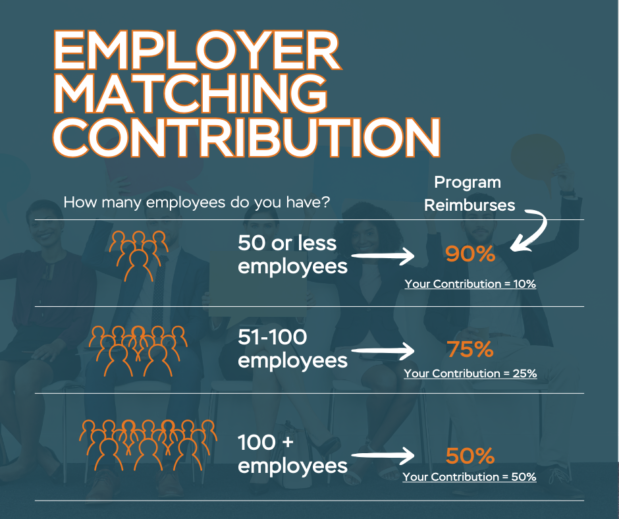Today’s job search can be complicated, but with the help of Heartland Workforce Solutions, we can simplify the process together. We have many programs, resources and support services for adults to assist with career goals.
Incumbent Worker Program
The Heartland Workforce Solutions board has set aside Incumbent Worker funding to be made available to businesses to ensure that employees of a company can acquire the skills necessary to retain employment and advance within the company, or to acquire the skills necessary to avert a layoff.
This program requires a percentage-based matching contribution by the employer based on various factors outlined in the policy and application. Local businesses are asked to provide a matching contribution ranging from 10-50% of the total cost:

Matching Requirments
Employers are required to pay a portion of the training. This may be done through both cash payments and fairly evaluated in-kind contributions. The employer contribution may include the wages the employer pays to the incumbent worker trainee while the worker is attending training.
Contract
If the request for funding is approved by the workforce board a contract will be developed outlining what training will be provided and how cost will be shared. A sample copy of an Incumbent Worker contact can be found [here].
Application and Proposal Requirments
Applying for the Incumbent Worker Training Program requires the completion of the application form. As part of completing this application form, you will be required to upload two documents:
- A Training Plan Proposal (limited to two pages max) (85 points)
- An Organizational Statement related to Diversity, Equity, Inclusion, and Accessibility (15 points).
Training Plan Proposal Requirements
There is a two page limit to the training plan proposal.
- A detailed description of all the training to take place, including the timelines and costs associated with the training (including the potential number of trainees). (25 points)
- Identification of the organization providing the training services and what credentials/certificates an individual might obtain as part of the training. (15 points)
- A description of how the training will benefit your organization. (15 points)
- A description of any impacts of this training on underrepresented populations within your industry or within the specific occupations being trained. (15 points)
For additional questions about the Incumbent Worker Training program, please contact Stan Odenthal
Additional Resources
Incumbent Worker Program Flyers
Incumbent Worker Program Presentations
Incumbent Worker Policies
Examples of Training under the Incumbent Worker Program
- Skills Upgrades: Funds may be used to for training programs that teach employees new skills relevant to their current roles, such as advanced software proficiency, technical skills, or industry-specific certifications.
- Language or Cultural Training: In diverse workplaces, funds may be used to provide language or cultural sensitivity training to facilitate better communication and understanding among employees.
- Professional Development: Employees can use these funds to attend workshops, conferences, or seminars to stay updated on industry trends, best practices, and new technologies.
- Cross-Training: Funds may be allocated to cross-train employees in different areas of the business, making them more versatile and adaptable to different roles within the company.
- Leadership Training: Investing in leadership and management training helps employees move into supervisory or managerial roles, fostering career growth within the organization.
- Compliance Training: In industries with constantly changing regulations, funds may be used to ensure that employees receive the necessary training to stay compliant with new laws and standards.
- Soft Skills Development: Training programs focused on developing soft skills like communication, teamwork, and problem-solving can contribute to a more effective and harmonious work environment.
- Adoption of New Technologies: As technology evolves, funds may be used to train employees on the use of new tools, software, or equipment to improve efficiency and productivity.
- Health and Safety Training: Ensuring a safe work environment is crucial. Funds can be used for training programs that educate employees on health and safety protocols and practices.
- Customer Service Training: In customer-centric industries, investing in training programs that enhance customer service skills can lead to improve customer satisfaction and loyalty.
These examples highlight the diverse ways in which Incumbent Worker Training funds can be utilized to benefit both employees and the organization as a whole.
